Video of the Week:
Planting a Fall Garden
Ornamentals:
Leaf Scorch on Maples
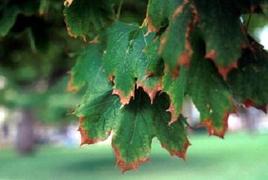
Scorched leaves turn brown or, in some cases, turn black from the edges and between the major veins. If severe, the leaf may drop. Leaves may be affected over the entire tree or may be affected only on one side. White pines are also prone to this condition due to the delicacy of the needles.
Though scorch can be due solely to the weather, the condition of the roots of plants can make them much more susceptible to this condition. Shallow soils such as those over hardpan or rock lead to a limited root system that may not be able to absorb all the water needed. Trees may be more sensitive to scorch this year because of the heavy rains some areas received in June. Though soils were recharged, in many cases so much rain was received that oxygen was driven from the soil resulting in root damage. That root damage is now making it more difficult for trees to provide all the water needed for the leaves. Also, root damage due to disease, insects, poor drainage or construction can cause poor water uptake.
To help alleviate damage due to dry soils or limited root systems, water once per week for recently transplanted trees of every two weeks for large trees if there is no rainfall. Mulching small trees or shrubs will help conserve moisture. (Ward Upham)
Flowers:
Peony "Measles"
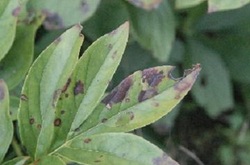
Sanitation is the best control for this disease. Remove all diseased tissue, including stems, at the end of the growing season. Mulch that contains plant debris should also be discarded and then replaced with fresh mulch. Reducing the source of the inoculum will reduce the chances of another severe outbreak next year. (Ward Upham)
Pests:
Cicada Killer Wasps
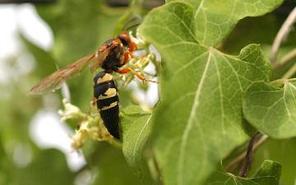
The cicada killer is a solitary wasp rather than a social wasp like the yellow jacket. The female nests in burrows in the ground. These burrows are quarter-size in diameter and can go 6 inches straight down and another 6 inches horizontally. Adults normally live 60 to 75 days from mid-July to mid-September and feed on flower nectar and sap. The adult female seeks cicadas on the trunks and lower limbs of trees. She stings her prey, flips it over, straddles it and carries it to her burrow. If she has a tree to climb, she will fly with it. If not, she will drag it. She will lay one egg per cicada if the egg is left unfertilized. Unfertilized eggs develop into males only. Fertilized eggs develop into females and are given at least two cicadas. Cicadas are then stuffed into the female’s burrow. Each burrow normally has three to four cells with one to two cicadas in each. However, it is possible for one burrow to have 10 to 20 cells. Eggs hatch in two to three days, and larvae begin feeding on paralyzed cicadas.
Feeding continues for four to 10 days until only the outer shell of the cicada remains. The larva overwinters inside a silken case. Pupation occurs in the spring. There is one generation per year.
Cicada killers are not dangerous, but they can be a nuisance. If you believe control is necessary, treat the burrows after dark to ensure the female wasps are in their nests. The males normally roost on plants near burrow sites. They can be captured with an insect net or knocked out of the air with a tennis racket during the day. Carbaryl (Sevin) or permethrin may be used for control. (Ward Upham)
Velvet Ants
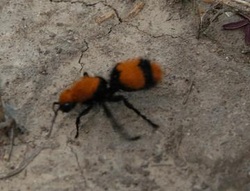
Grasshoppers
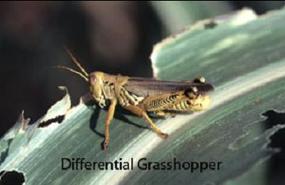
We often have gardeners who are interested in organic controls. Nosema locustae, a protozoan, is the active ingredient in a number of products including Semaspore, NOLO Bait, HopperStopper and Grasshopper Attack. These products are selective and will affect only grasshoppers. This is a trait many gardeners find attractive. However, Nosema locustae products may not be as effective in garden situations as they would be under large-scale rangeland conditions due to potential reinfestations from outside the treated area. Also, these products have other potential disadvantages:
- They are most effective against nymphal rather than adult grasshoppers. Also some grasshopper species are less susceptible than others.
- Kill can take 3 to 6 weeks after ingestion.
- These baits are perishable and should be kept refrigerated until use. Pay attention to the expiration date.
As mentioned above, reinfestations of uninfected grasshoppers can occur. These products are not effective against adults. Try to treat the nesting area when hoppers are small and populations are concentrated. Nosema locustae products are allowed in certified organic crop production.
Poultry including turkeys, guinea hens and chickens have also been used to help control grasshoppers.
Regardless of method used, the trick is to treat early before the population has matured. Young nymphal stages are much easier to control than adults and are also much less mobile. (Ward Upham)
Spider Mites
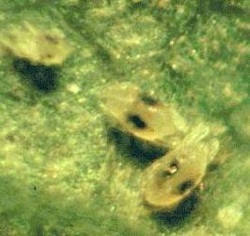
Spider mite control can be challenging. A strong jet of water can be used to remove the mites but may not be as easy as it sounds. A high-pressure directed spray is needed to dislodge the mites. Since spider mites feed on the underside of the leaves, the spray is most effective if it comes from below. This can be difficult to accomplish with a thumb over the end of the hose. The only commercial product I have been able to find that is made for this purpose is the Mite-Y-Fine Sprayer from miteyfine.com.
Horticultural oils and insecticidal soaps (Safers, for example) can also be helpful. Spray early in the morning when temperatures are cooler and plants have rehydrated. Resprays will likely be needed. (Ward Upham)
Squash Vine Borer
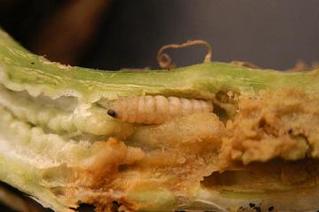
The adult of this insect is a clear-winged moth that resembles a wasp. The forewings are a dark metallic green but the rear wings are clear. The abdomen is orange with black spots. The larva is cream-colored and rather wrinkled. Adults emerge in the spring and lay eggs on or near susceptible plants. Larva bore into the plant and feed for about a month as they move toward the base. Mature larva will exit the plant, burrow into the soil and pupate where they remain until the next year. Each plant can have numerous borers. If you suspect squash vine borer, split the stem of a collapsed plant near where it enters the ground. Infested plants will be hollowed out and mushy and may contain borers. Unfortunately, there isn't much you can do at this late stage. Control measures should center on prevention.
Suggested preventative controls would include crushing the dull red eggs before they hatch, excavating larvae from stems before they cause much damage or using insecticide applications. Applications should begin when the vines begin to run (too late for that) and reapplied every 7 to 10 days for three to five weeks. Direct the spray at the crown of the plant and the base of runners. Chemicals used for borer control in gardens are permethrin (Bug-No-More Yard & Garden Insect Spray; Eight Vegetable, Fruit & Flower Concentrate; Lawn, Garden, Pet and Livestock Insect Control; Lawn & Garden Insect Killer), bifenthrin (Hi-Yield Bug Blaster II, Bug-B-Gon Max Garden Insect Killer) or carbaryl (Sevin), applied as sprays or dusts. Continue on a 7 to 10 day reapplication schedule for 3 to 5 weeks. If plants wilt, look for the presence of holes and ooze. However, in extreme heat, these plants will wilt in the afternoon even if undamaged by this insect. (Ward Upham)
 RSS Feed
RSS Feed
